Contents
- Unearthing of Jain idol calls for more excavations
- History: Conflict the Line of Actual Control
- Nuclear stockpile in last one year: report
- Supreme Court on Sex determination rules put on hold
- After over 4 years, wholesale prices in deflationary zone
- Curbs hit Urban Poor the Hardest
UNEARTHING OF JAIN IDOL CALLS FOR MORE EXCAVATIONS
Focus: GS-I History, Art and Culture
Why in news?
The unearthing of the statue of Lord Mahaveera in Kotla Narsimhlupalle village in Telangana, increasing focus on need for more excavations and investigations by Archaeological Survey of India (ASI).
Significance with respect to Rashtrakuta Dynasty
- An idol belonging to the 23rd Jain Theerthankara called Parshvanatha was found in the same fields earlier in 2007.
- The village is close to Bommalammagutta, which was the first capital of Rashtrakuta dynasty, which ruled the Telangana region and adopted Jainism.
- This village (Kotla Narsimhlupalle) is known for historical reasons because of location of the hillock ‘Devuni Gutta’ which houses the ancient Sri Laxmi Narasimha Swamy and Sri Annapoorna Vishwanatha temples dating back to 7th and 8th century of Imperial Rashtrakutas.
- The unique and rare sculptures (Bas-Relief) of Shodasha Babu Pancha Mukha Ugra (Bhargava) Narasimha seen here belongs to 4th and 5th century of Rashtrakutas.
- It is said that after the fall of Nanda dynasty and installation of Mourya dynasty, one of the Nandas fled from Pataliputra and had taken shelter on this hillock.
Tirthankaras
- In Jainism, a tirthankara is a saviour and spiritual teacher of the dharma (righteous path).
- The word tirthankara signifies the founder of a tirtha, which is a fordable passage across the sea of interminable births and deaths, the saṃsāra.
- According to Jains, a tirthankara is an individual who has conquered the saṃsāra, the cycle of death and rebirth, on their own, and made a path for others to follow.
Parshvanatha – 23rd of the 24 Tirthankaras
- Parshvanatha was the 23rd Tirthankara of Jainism, and was the earliest exponent of Karma philosophy in recorded history.
- Parshvanatha was born 273 years before Mahavira (Mahavira is the 24th and last Tirthankara).
- Parshvanatha is the earliest Jain tirthankara who is generally acknowledged as a historical figure.
- Parshvanatha attained moksha on Mount Sammeta (Madhuban, Jharkhand) in the Ganges basin, an important Jain pilgrimage site.
- Texts of the two major Jain sects (Digambaras and Śvētāmbaras) differ on the teachings of Parshvanatha and Mahavira, and this is a foundation of the dispute between the two sects.
About Archaeological Survey of India (ASI)
- The Archaeological Survey of India is an Indian government agency attached to the Ministry of Culture.
- ASI is responsible for archaeological research and the conservation and preservation of cultural monuments in the country.
- Maintenance of ancient monuments and archaeological sites and remains of national importance is the prime concern of the ASI.
- Besides it regulates all archaeological activities in the country as per the provisions of the Ancient Monuments and Archaeological Sites and Remains Act, 1958.
- It also regulates Antiquities and Art Treasure Act, 1972.
-Source: The Hindu
HISTORY: CONFLICT THE LINE OF ACTUAL CONTROL
Focus: GS-I History, Prelims
History: Aftermath of the 1962 war
- The end of the 1962 Indo-China war was marked when China had reached its claim lines so the PLA did not advance farther, and China declared a unilateral ceasefire.
- Chinese frontier guards were also withdrawn to positions 20 kilometers behind the Line of Actual Control that was established.
- According to the China’s official military history, the war achieved China’s policy objectives of securing borders in its western sector, as China retained de facto control of the Aksai Chin.
- After the war, India abandoned the Forward Policy, and the de facto borders stabilised along the Line of Actual Control.
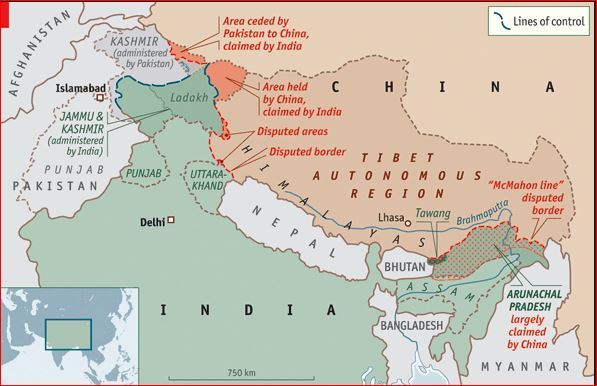
Developments in Sharing the Maps and gaining clarity
- The Chinese have not agreed to share maps on their perception on the eastern and western sectors of LAC first at the Joint Working Group (JWG) mechanism at foreign secretary-level agreed upon during 1988.
- In 1993 and 1996, the two sides signed the Sino-Indian Bilateral Peace and Tranquility Accords, agreements to maintain peace and tranquility along the Line of Actual Control (LoAC).
- Maps in the less contentious middle sector were shared at a JWG meeting in 2001.
- The two countries agreed to set up a dedicated mechanism at the level of Special Representatives (SRs) to resolve the border dispute in 2003.
- Though the SR mechanism led to a “guiding principles” agreement in 2005, the two countries are still to exchange maps on where each side is in the eastern and western sectors.
Conclusion
Over the years, India and China have agreed on a number of mechanisms to enhance confidence at the military level, but their inability to agree to a border settlement have led to consistent problems – troops coming into conflict with each other – and continues to be a pressing issue.
-Source: The Hindu
NUCLEAR STOCKPILE IN LAST ONE YEAR: REPORT
Focus: GS-II International Relations
Why in news?
According to a latest report:
- All nations that have nuclear weapons continue to modernise their nuclear arsenals.
- India and China increased their nuclear warheads in the 2019.
The availability of reliable information on the status of the nuclear arsenals and capabilities of the nuclear-armed states varied considerably.
Highlights of the progress in Nuclear Arsenal of Countries
- China is in the middle of a significant modernisation of its nuclear arsenal. It is developing a so-called nuclear triad for the first time, made up of new land and sea-based missiles and nuclear-capable aircraft.
- China’s nuclear arsenal had gone up from 290 to 320, India’s from 130 to 140, and Pakistan’s is estimated to have increased to 160. Both China and Pakistan continue to have larger nuclear arsenals than India.
- There are nine nuclear-armed states — the U.S., Russia, the United Kingdom, France, China, India, Pakistan, Israel and North Korea.
- Russia and the U.S. together possess over 90% of the global nuclear weapons.
- Russia and the U.S. have already announced extensive plans to replace and modernise their nuclear warheads and delivery systems.
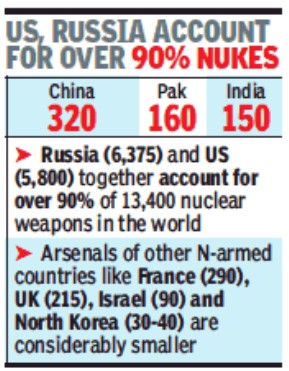
New START
- The U.S. and Russia have reduced their nuclear arsenals under the 2010 New Strategic Arms Reduction Treaty (New START).
- Discussions to extend the New START or negotiate a new treaty made no progress with the U.S.’s insistence that China must join any future nuclear arms reduction talks, which China has categorically ruled out.
-Source: The Hindu, Times of India
SUPREME COURT ON SEX DETERMINATION RULES PUT ON HOLD
Focus: GS-III Social Justice
Why in news?
The Supreme Court asked the government to explain its decision to suspend crucial rules of a parliamentary law against pre-natal sex determination and sex selection till the end of June 2020.
Background
- The Union Ministry of Health and Family Welfare put on hold the implementation of certain rules of the Pre-Conception and Pre-Natal Diagnostic Techniques (Prohibition of Sex-Selection Rules) of 1996 till June 2020.
- One of the suspended provisions, Rule 8, is intrinsically connected with the statute’s provisions dealing with the mandatory registration of genetic counselling centres, laboratories and clinics.
- This will result in misuse of technology by unscrupulous individuals who will no longer be deterred by the monitoring mechanism provided in the Rules
Importance of Banning Sex Determination in India
- The number of girls missing at birth due to the practice of gender biased sex selection in India has been estimated at 4.6 Lakh girls per year for the period 2001-12.
- According to the decennial Indian census, the sex ratio in the 0 to 6 age group in India is 108.9 males per 100 females in 2012, and it has been increasing.
- The natural sex ratio is assumed to be between 103 and 107, and any number above it is considered as suggestive of female foeticide.
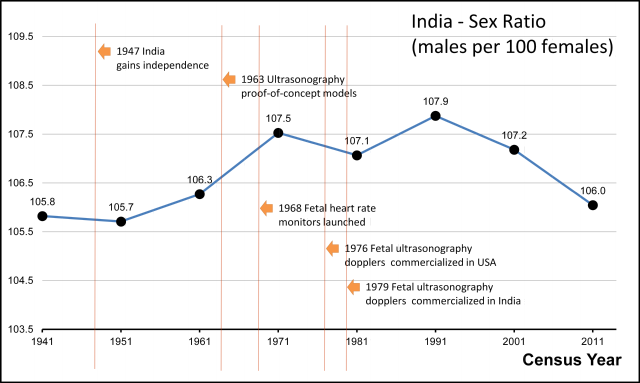
PC & PNDT Act of 1994
- Pre-conception and Pre-natal Diagnostic Techniques (Prohibition of Sex Selection) Act (PC & PNDT).
- The main purpose of the Act is to ban the use of sex selection and misuse of pre-natal diagnostic technique for sex selective abortions and to regulate such techniques.
- However, there are only 586 convictions out of 4202 cases registered even after 24 years of existence.
- PC & PNDT Act, 1994 was enacted in response to the decline in Sex ratio in India, which deteriorated from 972 in 1901 to 927 in 1991.
- The main purpose of enacting the act is to ban the use of sex selection techniques before or after conception and prevent the misuse of prenatal diagnostic technique for sex selective abortion.
- Offences under this act include conducting or helping in the conduct of prenatal diagnostic technique in the unregistered units, sex selection on a man or woman, conducting PND test for any purpose other than the one mentioned in the act, sale, distribution, supply, renting etc. of any ultra sound machine or any other equipment capable of detecting sex of the foetus.
PC & PNDT Amendment in 2003
- The act was amended in 2003 to improve the regulation of the technology used in sex selection. The Act was amended to bring the technique of pre conception sex selection and ultrasound technique within the ambit of the act.
- The amendment also empowered the central supervisory board and state level supervisory board was constituted.
- In 1988, the State of Maharashtra became the first in the country to ban pre-natal sex determination through enacting the Maharashtra Regulation of Pre-natal Diagnostic Techniques Act.
-Source: The Hindu
AFTER OVER 4 YEARS, WHOLESALE PRICES IN DEFLATIONARY ZONE
Focus: GS-III Indian Economy
Why in news?
Wholesale price inflation entered the deflationary zone for the first time in over four years, reflecting sharp dip in demand due to the lockdown enforced to stem the spread of the coronavirus.
Details
- Inflation, as measured by the wholesale price index (WPI), contracted in May 2020 almost as much as it showed growth in May 2019.
- This was the sharpest level of deflation witnessed since November 2015.
- The National Statistical Office (NSO) too did not release the headline CPI inflation data and only provided some sectoral numbers due to lack of data.
- The inflation in food articles moderated largely due to a decline in cost of vegetable, onions, food grains and pulses.
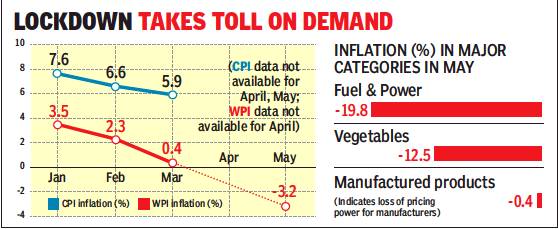
Exports and Imports down in May 2020
- India’s exports fell by more than 35% in May after a historic 60% drop in April, while imports crashed more than 50%.
- The sharper fall in imports resulted in the trade deficit narrowing.
-Source: Times of India
CURBS HIT URBAN POOR THE HARDEST
Focus: GS-III Indian Economy
Why in news?
Studies suggest that even in the most optimistic scenario, close to 30% of India’s urban population could be out of savings and unable to cover essential expenditure by June-end.
The rural poor—though hit hard—are relatively better off with still some savings and welfare support to fall back on.
Details: Estimating the effects of Impact
- According to a survey, 84% of households suffered a loss in income since the lockdown.
- As incomes fell, Indians had to rely more on their savings to cover essential expenditure.
- But for the poorest in cities, these savings rapidly dried up.
- Given the government’s support to farmers and quicker reopening of the economy in rural areas, rural Indians would be able to cover essential consumption.
- Urban India, about 140 million Indians would still run out of savings by the end of this month.
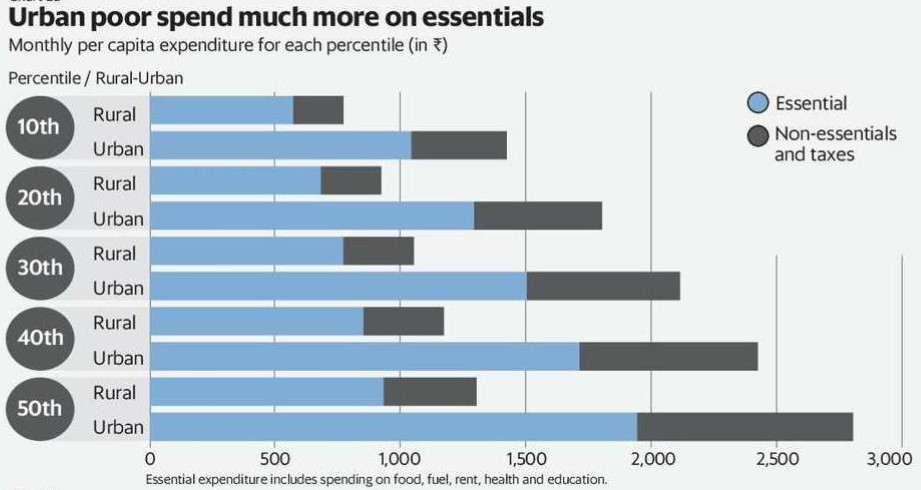
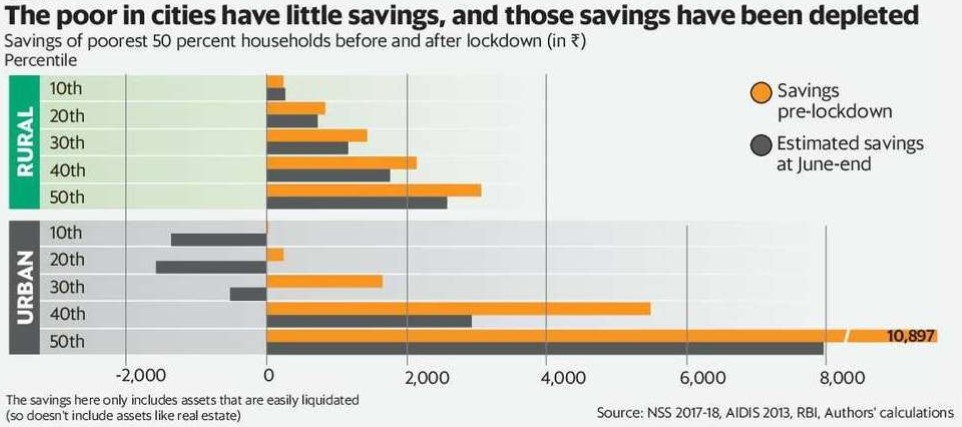
Why is the Urban poor suffering more?
- Poor urban Indians have been hit harder because they spend much more on essentials while having much smaller savings to fall back on.
- Data suggests that the poorest 20% in cities have lower savings than their rural counterparts but still spend much more on essentials.
- The rural poor have been less affected because they have seen some amount of government support such as help via the PDS and cash transfers.
-Source: Livemint





